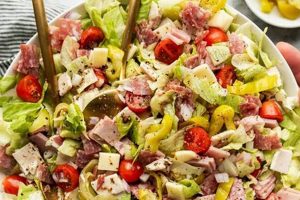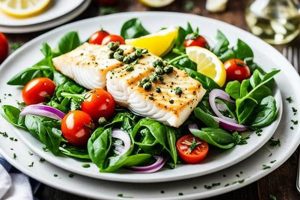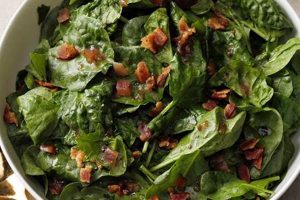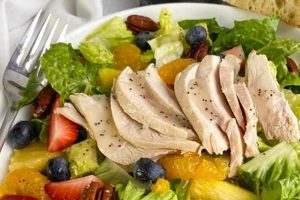A blend of dried herbs and spices designed specifically to enhance the flavor of salads constitutes a crucial element in culinary practice. Such a mixture might include common ingredients like dried onion, garlic, paprika, celery seed, dill, and parsley, but variations can incorporate more complex flavors using ingredients like lemon peel, chives, or smoked paprika. A well-crafted blend elevates simple greens and vegetables, transforming a basic salad into a flavorful and enjoyable meal.
Distinctive flavor profiles achievable through these specialized mixtures offer cooks considerable versatility. They provide a convenient shortcut to complex flavor combinations, eliminating the need to measure individual spices while ensuring consistent results. Historically, such blends evolved from practical needs, preserving seasonal herbs and combining flavors for convenience and efficiency. This practice continues to be valued for its ability to streamline meal preparation and introduce diverse tastes to everyday dishes. Such flavor enhancements contribute to increased enjoyment of healthy foods, promoting better dietary choices.
The following sections explore various aspects of flavor creation in salads. Specific examples of popular herb and spice combinations will be examined, along with guidance on creating custom blends tailored to individual preferences. Techniques for incorporating these mixtures into different salad types will also be detailed, offering readers practical advice and inspiration for culinary experimentation.
Tips for Elevating Salad Flavor
Optimizing the use of dried herb and spice blends in salads requires attention to several key factors. The following tips offer guidance for maximizing flavor and achieving desired culinary results.
Tip 1: Balance is Key: Avoid overpowering delicate greens with excessively strong flavors. Start with a small amount of seasoning and adjust incrementally until the desired taste is achieved.
Tip 2: Freshness Matters: Dried herbs and spices lose potency over time. Store blends in airtight containers in a cool, dark place to maintain freshness and maximize flavor impact.
Tip 3: Toasting Enhances Flavor: Briefly toasting spices in a dry pan before adding them to a salad can amplify their aromas and deepen their flavor profiles.
Tip 4: Consider the Salad Ingredients: Different salad components pair well with specific flavor profiles. Lighter blends complement delicate greens, while robust mixtures enhance heartier vegetables and grains.
Tip 5: Experiment with Custom Blends: Explore different combinations of herbs and spices to create unique flavor profiles tailored to individual preferences. Consider regional culinary traditions for inspiration.
Tip 6: Incorporate Blends into Dressings: Enhance the flavor of salad dressings by whisking in a small amount of the chosen seasoning blend. This ensures even distribution of flavor throughout the salad.
Tip 7: Timing is Crucial: Add seasonings just before serving to prevent the salad from becoming soggy or wilted.
By understanding these key principles, one can leverage the versatility of seasoning blends to consistently create flavorful and enjoyable salads.
The insights provided throughout this discussion aim to empower culinary exploration and promote the creation of exceptional salads. Experimentation and mindful ingredient selection are key to achieving desired results.
1. Balanced Flavor Profile
A balanced flavor profile is paramount in crafting a truly exceptional salad. This balance refers to the harmonious interplay of sweet, sour, salty, bitter, and umami elements within the dish. Achieving this equilibrium elevates the overall sensory experience, ensuring that no single flavor dominates and that each ingredient contributes to a cohesive and satisfying whole. In the context of a “recipe salad supreme seasoning,” this balance becomes even more crucial, as the seasoning itself plays a pivotal role in orchestrating the final flavor composition.
- Sweetness and Acidity
The interplay of sweetness and acidity provides a foundational layer of balance. A touch of sweetness, perhaps from dried fruits or a hint of sugar in the seasoning blend, can temper the sharpness of acidic elements like vinegar or citrus juice. This dynamic interaction prevents the salad from being overly tart and adds a dimension of complexity. For example, a blend incorporating a small amount of dried apple or mango can balance the brightness of lemon juice in a vinaigrette.
- Salt and Bitter Notes
Salt acts as a flavor enhancer, accentuating the inherent flavors of the other ingredients. Bitterness, often found in leafy greens or certain herbs, provides a counterpoint to the salt and other flavors. A carefully calibrated balance between these elements prevents the salad from being overly salty or unpleasantly bitter. Incorporating a small amount of sea salt or Himalayan pink salt into a seasoning blend can enhance the other flavors while a touch of dried oregano can provide a balancing bitterness.
- Umami Depth
Umami, often described as a savory, meaty flavor, adds depth and richness to the salad. Ingredients such as dried mushrooms, seaweed flakes, or nutritional yeast can contribute umami notes to the seasoning blend. This element rounds out the flavor profile, creating a more satisfying and complex experience. For example, incorporating a small amount of powdered shiitake mushrooms into the seasoning can significantly enhance the umami character of the salad.
- Aromatic Complexity
The aromatic complexity of a salad also contributes to a balanced flavor profile. A well-crafted seasoning blend can introduce a variety of aromatic notes from herbs and spices. These aromas engage the sense of smell, enhancing the overall enjoyment of the salad. The careful selection of ingredients like dried basil, mint, or coriander can add layers of aromatic complexity, further elevating the sensory experience.
By carefully considering these facets of flavor balance when creating a “recipe salad supreme seasoning,” one can ensure a truly exceptional and harmonious culinary creation. The strategic combination of sweet, sour, salty, bitter, and umami elements, along with the introduction of aromatic complexity, elevates the simple act of enjoying a salad to a sophisticated and satisfying gastronomic experience.
2. High-Quality Ingredients
The foundation of a truly exceptional “recipe salad supreme seasoning” rests upon the selection of high-quality ingredients. Superior components contribute not only to enhanced flavor but also to the overall nutritional value and sensory appeal of the final product. Understanding the nuances of ingredient quality is crucial for achieving culinary excellence in salad preparation.
- Sourcing and Freshness
The origin and freshness of ingredients significantly impact the quality of a seasoning blend. Herbs and spices sourced from regions known for their superior cultivation practices often possess more intense and nuanced flavors. Freshly dried herbs, as opposed to those that have been stored for extended periods, retain their volatile oils and aromatic complexity, resulting in a more vibrant and flavorful seasoning.
- Purity and Adulteration
Ingredient purity plays a vital role in ensuring the quality and authenticity of a seasoning blend. Adulteration, the practice of adding fillers or inferior substitutes to reduce costs, can compromise both flavor and nutritional value. Selecting ingredients from reputable suppliers who prioritize purity and adhere to stringent quality control measures is essential for crafting a premium seasoning.
- Processing Methods
The methods employed in processing ingredients can significantly influence their quality and characteristics. Gentle drying techniques, such as air drying or freeze-drying, help preserve the volatile oils and delicate flavors of herbs and spices. Harsh processing methods, on the other hand, can diminish flavor and degrade nutritional content. Understanding the processing methods employed by suppliers can provide valuable insights into the overall quality of the ingredients.
- Organic and Sustainable Practices
The increasing demand for organic and sustainably produced ingredients reflects a growing awareness of the interconnectedness between food production and environmental health. Choosing ingredients cultivated using organic and sustainable practices not only supports responsible agriculture but also contributes to a healthier and more flavorful seasoning. These ingredients are typically free from harmful pesticides and chemicals, ensuring a cleaner and more wholesome final product.
By prioritizing high-quality ingredients in a “recipe salad supreme seasoning,” one elevates the culinary experience, maximizing flavor, nutrition, and overall enjoyment. Careful attention to sourcing, freshness, purity, processing methods, and sustainability ensures a truly exceptional and wholesome seasoning blend, transforming a simple salad into a culinary masterpiece.
3. Freshly Dried Herbs
Freshly dried herbs constitute a cornerstone of superior “recipe salad supreme seasoning,” contributing significantly to its aromatic complexity and overall flavor profile. Their inclusion elevates a basic blend, transforming it into a culinary asset capable of enhancing a wide array of salads. Understanding the multifaceted role of freshly dried herbs is crucial for maximizing their potential in crafting exceptional seasonings.
- Preservation of Volatile Oils
Freshly dried herbs retain a higher concentration of volatile oils compared to their older counterparts. These oils, responsible for the characteristic aromas and flavors of herbs, are delicate and susceptible to degradation over time. Prompt drying after harvest minimizes oil loss, preserving the vibrancy and potency of the herbs for use in seasoning blends. This preservation translates to a more pronounced and authentic herbal presence in the finished salad.
- Enhanced Flavor Concentration
The drying process concentrates the flavors present in fresh herbs. As moisture content decreases, the remaining flavor compounds become more densely packed, resulting in a more intense taste. This concentration allows for a smaller quantity of dried herbs to deliver a comparable or even greater flavor impact than a larger amount of fresh herbs, making them ideal for seasoning blends.
- Extended Shelf Life and Versatility
Drying significantly extends the shelf life of herbs, allowing for year-round availability and convenient storage. This extended shelf life makes dried herbs a practical and versatile ingredient for seasoning blends, ensuring access to a wide range of flavors regardless of seasonality. A properly stored collection of dried herbs empowers culinary creativity and facilitates spontaneous salad preparation.
- Contribution to Complex Flavor Profiles
Freshly dried herbs contribute intricate layers of flavor to a seasoning blend. The unique aromatic profiles of individual herbs, when combined judiciously, create a synergistic effect, resulting in a depth of flavor that surpasses the sum of its parts. For example, the peppery notes of oregano can complement the sweetness of basil, while the earthy undertones of thyme can provide a balancing contrast. This interplay of flavors elevates the sensory experience of the salad, transforming it from a simple dish into a culinary delight.
The incorporation of freshly dried herbs into “recipe salad supreme seasoning” demonstrably enhances its culinary potential. From the preservation of volatile oils and concentrated flavors to their extended shelf life and contribution to complex flavor profiles, freshly dried herbs play an indispensable role in achieving superior seasoning blends. Their inclusion ensures not only a more flavorful but also a more aromatically nuanced and versatile seasoning, capable of elevating a wide array of salads to new culinary heights.
4. Complementary Spices
Complementary spices represent a critical component within a “recipe salad supreme seasoning,” contributing depth, complexity, and a nuanced flavor profile that elevates salads beyond the ordinary. Their judicious selection and incorporation significantly influence the overall sensory experience, transforming a simple salad into a culinary masterpiece. The following facets illuminate the intricate interplay between complementary spices and the creation of exceptional salad seasonings.
- Balancing Flavor Profiles
Complementary spices play a crucial role in balancing the overall flavor profile of a salad seasoning. They can temper dominant flavors, enhance subtle notes, and introduce contrasting elements that create a harmonious and well-rounded taste. For instance, the warmth of cinnamon can balance the brightness of citrus zest, while the earthiness of cumin can complement the sweetness of dried fruits. This interplay of flavors prevents any single element from overpowering the others, resulting in a balanced and nuanced seasoning.
- Enhancing Aromatic Complexity
The aromatic complexity of a salad seasoning is significantly enhanced by the inclusion of complementary spices. Each spice possesses a unique aromatic profile, and their combination creates a synergistic effect, resulting in a multi-layered sensory experience. The warm, inviting aroma of nutmeg can blend harmoniously with the pungent notes of black pepper, while the floral fragrance of cardamom can complement the herbaceous scent of dried thyme. This interplay of aromas elevates the salad beyond mere sustenance, engaging multiple senses and enriching the dining experience.
- Adding Depth and Dimension
Complementary spices contribute depth and dimension to salad seasonings, moving beyond one-dimensional flavor profiles. They introduce layers of complexity that unfold gradually on the palate, creating a more engaging and satisfying culinary experience. The subtle heat of paprika can add depth to the sweetness of dried apricots, while the pungent bite of ginger can enhance the savory notes of dried mushrooms. This interplay of flavors adds intrigue and complexity to the salad, transforming it into a multi-sensory delight.
- Cultural and Regional Influences
Complementary spices often reflect cultural and regional culinary traditions, introducing diverse flavor profiles to salad seasonings. The use of specific spice combinations can evoke the essence of particular cuisines, adding an element of authenticity and culinary exploration to the salad experience. For example, a blend incorporating cumin, coriander, and turmeric can evoke the flavors of Indian cuisine, while a combination of oregano, basil, and garlic can transport the palate to the Mediterranean. This incorporation of cultural influences broadens the culinary horizons of salad preparation, offering a world of flavor possibilities.
The strategic incorporation of complementary spices within a “recipe salad supreme seasoning” is essential for achieving a balanced, complex, and nuanced flavor profile. Their careful selection and combination elevates the sensory experience of the salad, transforming it from a simple dish into a culinary exploration. By understanding the interplay of flavors, aromas, and cultural influences, one can harness the power of complementary spices to create truly exceptional and memorable salad seasonings.
5. Proper Storage
Proper storage of “recipe salad supreme seasoning” is paramount for preserving its quality, potency, and intended flavor profile. Neglecting appropriate storage practices can lead to degradation of volatile oils, oxidation of delicate spices, and a diminished sensory experience. Maintaining the integrity of the seasoning blend requires careful attention to environmental factors and appropriate containment strategies.
- Airtight Containers
Storing the seasoning blend in airtight containers is crucial for preventing exposure to air and moisture, both of which contribute to flavor degradation. Airtight containers create a barrier that protects the delicate herbs and spices from oxidation and humidity, preserving their volatile oils and preventing the development of off-flavors. Glass jars with tightly sealed lids or high-quality plastic containers with airtight seals are ideal for maintaining the freshness and potency of the seasoning.
- Cool, Dark, and Dry Environment
Exposure to light, heat, and moisture can accelerate the degradation of dried herbs and spices. Storing the seasoning blend in a cool, dark, and dry environment mitigates these detrimental effects. A pantry or cupboard away from direct sunlight and heat sources provides optimal storage conditions. Avoiding storage near ovens, stoves, or dishwashers helps maintain the integrity of the seasoning blend and prevents premature loss of flavor and aroma.
- Proper Labeling and Organization
Clear labeling and organized storage practices contribute to efficient kitchen management and prevent the accidental use of stale or expired seasonings. Labeling containers with the date of creation or purchase allows for easy identification and ensures that older blends are used first. Organizing stored seasonings alphabetically or by flavor profile facilitates quick retrieval and streamlines the meal preparation process.
- Regular Inventory and Replenishment
Periodically assessing the inventory of stored seasonings allows for timely replenishment and prevents the use of stale or ineffective blends. Discarding outdated seasonings and replacing them with fresh supplies ensures optimal flavor and potency. This practice contributes to consistently high-quality culinary creations and prevents the disappointment of using a subpar seasoning blend.
Implementing these proper storage practices ensures the longevity and efficacy of “recipe salad supreme seasoning,” preserving its intended flavor profile and maximizing its culinary potential. Careful attention to airtight containers, environmental conditions, labeling, and inventory management safeguards the investment in high-quality ingredients and contributes to consistently exceptional salad creations. By adhering to these guidelines, one can confidently utilize the seasoning blend to elevate salads to new heights of flavor and enjoyment.
6. Precise Measurement
Precise measurement forms the cornerstone of replicating successful culinary outcomes, particularly within the context of “recipe salad supreme seasoning.” Consistent flavor profiles rely on the accurate proportioning of individual ingredients within a blend. The interplay of various herbs and spices contributes to the overall balance and complexity of the seasoning; deviations from prescribed measurements can lead to unpredictable and potentially undesirable results. For example, an excessive amount of cayenne pepper can overpower the other components, while insufficient oregano might render its characteristic flavor imperceptible.
Furthermore, precise measurement facilitates adaptability and customization. Once a baseline recipe is established through accurate measurements, modifications can be implemented systematically. Reducing the quantity of garlic powder by a specific percentage allows for a controlled reduction in its pungency, while incrementally increasing the amount of dried basil allows for a gradual enhancement of its herbaceous notes. This controlled manipulation empowers culinary experimentation and enables the development of personalized flavor profiles tailored to individual preferences or dietary requirements.
Culinary precision, facilitated by accurate measurement, contributes not only to consistent flavor replication but also to a deeper understanding of flavor interactions. Reproducible results provide a platform for systematic exploration and refinement of seasoning blends. Understanding the impact of specific ingredient ratios empowers informed decision-making in recipe development and adaptation. The pursuit of culinary excellence hinges on the meticulous application of precise measurement, enabling the creation of consistently balanced, nuanced, and ultimately, “supreme,” salad seasonings.
7. Creative Experimentation
Creative experimentation forms an integral aspect of developing exceptional “recipe salad supreme seasonings.” It transcends the mere following of established formulas, encouraging exploration and innovation within the culinary realm. This experimentation serves as a catalyst for discovering novel flavor combinations and achieving personalized taste profiles. The process often involves a departure from traditional ingredient pairings, incorporating unexpected elements that contribute unique dimensions to the seasoning blend. For instance, the inclusion of smoked paprika in a Mediterranean-inspired blend or the addition of dried lavender to a citrus-based seasoning can yield surprisingly delightful results, adding layers of complexity and intrigue.
The practical significance of creative experimentation lies in its capacity to elevate the sensory experience of a salad. It allows for the development of seasonings that cater to specific palates and culinary objectives. A desire for a bolder flavor profile might lead to the incorporation of spices like star anise or Szechuan peppercorns, while a preference for subtle nuances could inspire the use of ingredients like rose petals or saffron. Furthermore, experimentation fosters a deeper understanding of flavor interactions and balances, enabling the creation of truly bespoke seasoning blends. A chef might discover that the earthy notes of cumin harmonize exceptionally well with the sweetness of dried mango, or that the citrusy tang of lemon zest amplifies the herbaceous aroma of thyme. These discoveries, born from experimentation, contribute to the development of unique and personalized “salad supreme” experiences.
Systematic documentation of experimental variations plays a crucial role in refining and replicating successful outcomes. Detailed records of ingredient ratios, processing techniques, and sensory evaluations provide a valuable resource for future culinary endeavors. This meticulous approach allows for iterative improvements and ensures consistency in replicating desired flavor profiles. Challenges in creative experimentation often arise from balancing innovation with palatability. While exploring unconventional flavor combinations can yield exciting results, it’s essential to maintain a focus on creating seasonings that are both intriguing and enjoyable. Creative experimentation, therefore, represents a dynamic interplay between culinary artistry and scientific methodology, driving innovation while upholding the fundamental principle of creating delectable and “supreme” salad experiences.
Frequently Asked Questions
This section addresses common inquiries regarding the development and utilization of optimized salad seasonings.
Question 1: What distinguishes a “supreme” salad seasoning from a standard blend?
A “supreme” designation suggests a superior level of quality, characterized by freshly dried herbs, premium spices, and a meticulously balanced flavor profile. It often involves a nuanced approach to ingredient selection and preparation, resulting in a more complex and flavorful seasoning blend.
Question 2: How does one determine the optimal balance of herbs and spices in a custom blend?
Optimal balance is subjective and depends on individual palate preferences. Start with small quantities of each ingredient, gradually adjusting ratios until a harmonious flavor profile is achieved. Systematic experimentation and careful tasting are essential for achieving desired results.
Question 3: Can store-bought seasonings achieve the same level of quality as homemade blends?
Store-bought seasonings can offer convenience, but achieving the “supreme” designation often necessitates the control afforded by homemade blends. Sourcing high-quality ingredients and customizing ratios allows for superior flavor profiles tailored to specific preferences.
Question 4: What storage practices maximize the shelf life and potency of dried herbs and spices?
Storing dried herbs and spices in airtight containers in a cool, dark, and dry environment mitigates degradation and preserves volatile oils, maximizing their flavor and potency over time. Regular inventory assessment ensures timely replenishment, preventing the use of stale ingredients.
Question 5: How does one adapt a seasoning blend to complement specific salad ingredients?
Consider the inherent flavors of the salad components when selecting herbs and spices. Delicate greens benefit from lighter, more nuanced seasonings, while robust vegetables and proteins can handle bolder, more assertive flavor profiles. Harmonizing the seasoning with the salad’s composition is key.
Question 6: What role does ingredient quality play in the overall efficacy of a salad seasoning?
Ingredient quality directly impacts the final flavor profile. Sourcing freshly dried herbs and premium spices significantly enhances the complexity and depth of the seasoning blend. Prioritizing quality ensures a superior culinary outcome.
Understanding these key aspects of salad seasoning preparation facilitates the creation of truly exceptional culinary experiences. Careful attention to ingredient selection, precise measurement, and proper storage ensures optimal flavor and enjoyment.
For further exploration of specific salad recipes and techniques, please continue to the next section.
Recipe Salad Supreme Seasoning
Exploration of optimal “recipe salad supreme seasoning” necessitates meticulous attention to detail. Ingredient quality, precise measurement, and proper storage significantly impact the final flavor profile and overall culinary experience. Freshly dried herbs and complementary spices, when combined judiciously, elevate salads from simple fare to gastronomic delights. A balanced flavor profile, achieved through careful consideration of sweet, sour, salty, bitter, and umami elements, ensures a harmonious and satisfying sensory experience. Furthermore, creative experimentation, grounded in systematic documentation, unlocks the potential for personalized flavor combinations and culinary innovation.
Mastery of “recipe salad supreme seasoning” empowers culinary artisans to transform ordinary salads into extraordinary culinary creations. Continued exploration of flavor profiles, ingredient combinations, and innovative techniques promises further enhancement of salad preparation, enriching dining experiences and promoting culinary artistry.






